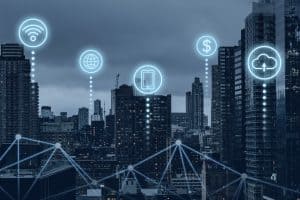One of the peculiarities of technological advances today is that they happen faster than ever before. We went from having a blue screen phone and ringtones to a multifunctional device with global connectivity in the blink of an eye. Still, modern users demand more: faster data speeds and unprecedented connection methods. These demands have given way to the so-called fifth generation of wireless networks, 5G technology.
However, this has also become a challenge for enterprise-level cybersecurity in 2021. Because as we pursue the connected future, we must pay equal attention to the security of those connections. And hence the question: are you ready for 5G technology?
What is 5G technology?
Simply put, 5G is the fifth generation of mobile networks. But the big difference between 5G technology and other connection standards such as 1G, 2G, 3G and 4G is that it is designed to connect virtually everyone and everything. Including machines, objects and devices.

5G wireless technology is intended to offer peak data rates of up to 2.5 GB/s (gigabytes per second), ultra-low latency, higher reliability and massive network capacity. Where users should be able to download a high-definition movie in less than a second.
With high speeds, superior reliability and negligible latency, 5G technology is to take digital communications to a never-before-seen experience.
Bringing to fruition stupendous technological advancements. Safer transportation, remote healthcare, digitized logistics, banking networks, digital asset records and control, and more.
However, with 5G, it also opens cyber doors and vulnerabilities. As the use of IoT devices continues to grow, they are increasingly connected to critical networks. Moreover, cyberattackers are adapting their working strategies accordingly and targeting their activities more intelligently. Attacking IoT applications, which has become the massive weak points in enterprise networks and devices.
Why does 5G technology require a different cybersecurity approach?
76.4% of professionals at organizations currently use 5G and 80.7% of professionals at organizations plan to adopt 5G in the next year, according to a Deloitte survey. This makes most professionals and their organizations also concerned about the cybersecurity risks associated with 5G technology adoption.
Because while 5G is susceptible to many of the same traditional cybersecurity risks, it is also subject to new avenues of attack. Because this new connectivity standard relies on decomposed, virtualized and distributed network functions. And such convergence both exposes new cyberattack points and poses challenges in cybersecurity management. So, we require a different approach to protect a new technology from cyber-attacks.
In addition, the connection of the virtual world and the real world by 5G technology means that if a given network infrastructure is compromised, the consequences will not be limited to the digital world alone. Attackers can target connected physical devices, such as sensors and cameras, and allow them to be taken over and used for distributed denial of service (DDoS) attacks. In addition, due to the speed of attacks, they are becoming more withering and without a rapid response the consequences could be irreparable.
Cyber-risks are evolving as well
It is a fact that the dramatic expansion of bandwidth made possible by 5G creates new avenues of attack. And with new avenues also come new modus operandi, or evolved cyber-risks.
5G technology generates vulnerabilities with a greater scope. By connecting millions of vulnerable smart devices to the IoT network. Cyber hackers position themselves specifically to attack a diverse list. From public safety issues, to a smart home, a healthcare institution and its implements, or a transportation network such as UBER.

The network has moved away from centralized, hardware-based switching to distributed, software-defined digital routing. Before, constriction points allowed the practice of cyber-hygiene. However, in the software-defined 5G network, this activity is moved to a network of digital routers throughout the network, negating the potential for inspection and control of constriction points.
5G technology further complicates cybersecurity by virtualizing into software high-level network functions previously performed by physical devices. These activities are based on the common Internet Protocol language and familiar operating systems. Whether used by nation-states or criminal actors, these standardized protocols and building systems have proven to be valuable tools for cyber hackers.
Enterprises in 2021 need new methods of adaptation
Keeping security at the forefront of 5G technology adoption is the task for every leading enterprises. Just as the COVID-19 disruption was.
Smart homes and smart offices are not the limit for the development of 5G networks. It also will be useful for large-scale industries and infrastructure development as parts of the smart economy and smart cities. The development of 5G technology therefore becomes the goal of increasing the competitiveness of many economies around the world.
We need to implement new methods of adaptation. If cyber risk is increasing rapidly then the secret lies in getting the right talent or upgrading it; and, leveraging artificial intelligence and machine learning to automate areas such as security policy configuration, compliance monitoring, and threat and vulnerability detection.
The new capabilities that make possible the new applications that 5G networks mount hold great promise. However, building 5G on a weak cybersecurity foundation is building on sand. It’s not just about the security of network users, but even national security.
Why implement cybersecurity software?
When we implement 5G technology that causes network functions to change dynamically, cyber protection must also be dynamic rather than relying on a uniform lowest common denominator solution. Since cyber-attacks on 5G will be software attacks; then we should use software protections against it.
Because it is not possible to counter software attacks with human teams. That is, if the attackers are machines, our approach must be to provide intelligent, automated tools that can respond at the same level. The speed and breadth of computer-driven cyberattacks require the speed and breadth of computer-driven protections at all levels.
Software companies and those providing innovative software-based products and services go hand-in-hand with cybersecurity measures. As a design, deployment and maintenance consideration for every new project. This security by design should be a minimum duty of care throughout the commercial space for innovations in the emerging 5G technology environment.
Conclusions

Proactive investment in cybersecurity is a necessity today. Even more when companies have a role in critical infrastructure or provide a product or service that, if attacked, could jeopardize public safety. It is imperative to address cybersecurity risks proactively.
A secure 5G network will not only benefit vendors and service providers, but will also build consumer confidence. Therefore, being a leader in 5G is not just about the ability to deploy networks nationwide. It is also about the effectiveness of your cybersecurity ecosystem.
Tools like Tenable can become an effective ally when it comes to detecting vulnerabilities that can be exploited from IoT devices. Helping your company to respond more quickly and efficiently to the various risks faced after the implementation of 5G technology. And allowing enterprises to exploit the advantages in a secure environment.
If you want to know more about Tenable and how to implement it in your company, contact Gb-Advisors. A group of specialists dedicated to helping companies in various sectors to implement technological tools tailored to their needs.



